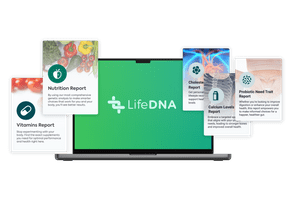A Full Walkthrough of the LifeDNA Nutrition Report
Aira
on
August 19, 2024
The rise of personalized nutrition is heralded as the future of health and wellness. As research delves deeper into understanding how our genes influence our nutritional needs, companies have risen to the challenge. Among the pioneers in this field is LifeDNA. Our Nutrition report perfectly exemplifies how cutting-edge science can translate into actionable consumer insights. This article comprehensively examines the LifeDNA Nutrition report and its significance to personalized wellness.
What is the LifeDNA Nutrition Report?
LifeDNA’s Nutrition report gives you insights into your genetic predispositions related to nutrition. This personalized report highlights how your genes influence your dietary needs, likelihood for sensitivities, and how you are likely to metabolize various nutrients.
Scientific Basis of the Report
The foundation of the LifeDNA Nutrition report lies in the rapidly expanding fields of nutrigenetics and nutrigenomics. Nutrigenetics and nutrigenomics explore the relationship between genes, nutrition, and health. Scientists can estimate how an individual might react to certain foods or nutrients by examining specific genetic markers. However, it is essential to understand that genetics is just one piece of the puzzle. Lifestyle, environment, and other factors are also significant in health and nutrition.
Key Features of the Report
Nutritional Recommendations
Our report offers personalized dietary guidelines based on your unique genetic makeup. It can include suggestions on the type of diet that may work best for you, optimal macronutrient ratios, and potential nutrient deficiencies you should watch out for.
Food Sensitivities
Not everyone processes food the same way. The Nutrition report provides insights into potential food intolerances or sensitivities you might have, such as lactose intolerance or gluten sensitivity.
Insights on Metabolism
Some people metabolize caffeine quickly, while others do not. These metabolism insights help you understand how you process certain substances, which can guide your consumption habits.
LifeDNA Nutrition Report Traits
Carbohydrate Metabolism
We can all admit that carbohydrates (or carbs, as we call them) rule our plates! We try to avoid them as much as possible, but they are too delicious! What if there is a way to eat carbs responsibly? Eat them to enjoy their benefits while minimizing the side effects.
The answer to this question is to know how our bodies break down (or metabolize) carbohydrates. For example, the complex carbs we eat (the yams you could not resist at Thanksgiving) are broken down into simple carbohydrates (mainly glucose or blood sugar) and used by your cells for energy. Some bodies can digest the complex carbs well, while others need more help.
Understanding your carbohydrate metabolism can help you make informed dietary decisions to maintain consistent energy levels and manage your blood sugar. For example, those who can digest and utilize carbs well could get away with eating more than their slow-digesting friends. Still, carbs in moderation is a better option than no carbs!
There are known genetic variations that influence carbohydrate digestion. For example, the AMY1 gene produces salivary amylase, an enzyme in saliva. As you chew food, salivary amylase starts breaking down starches (complex carbohydrates) into maltose and maltotriose, smaller carbohydrate molecules. Studies have shown that individuals with more copies of the AMY1 gene, and consequently higher salivary amylase levels, might be better adapted to digest starchy foods efficiently.
Saturated Fat Metabolism
We can find plenty of saturated fats in our daily nutrition. From butter and margarine to fatty fish and baked goods, even the most health-conscious of us take in quite a bit of these macromolecules in a week.
Saturated fat metabolism refers to your body’s ability to process and break down saturated fats. Saturated fats influence cholesterol levels and, consequently, cardiovascular health. Optimally, knowing your metabolic response to saturated fats can help you make practical changes to your diet to support heart health.
For example, APOA2 plays a role in the metabolism of dietary fats, including saturated fats. Specifically, variations in the APOA2 gene can influence your response to saturated fat intake in terms of body weight and obesity risk.
Sodium Sensitivity
Controlling your sodium intake is one of the most challenging aspects of managing your diet because salt is everywhere! Bread, meat, canned vegetables, salad dressings, sauces, snacks, frozen foods- you name it. Sodium sensitivity refers to variation in blood pressure response to dietary salt intake among individuals. Knowing your sodium sensitivity can help you adjust your salt intake to manage blood pressure better. Maintaining blood pressure within a healthy range can reduce the undue strain on the heart and arteries, ensuring they function as they should. It also prevents hypertension, one of the leading causes of death globally.
The ADD1 gene, which stands for alpha-adducin 1, plays a role in regulating blood pressure. Variants within this gene have been associated with an individual’s sensitivity to dietary salt. In particular, certain genetic variations in the ADD1 gene influence how an individual’s blood pressure responds to salt intake.
Gluten Sensitivity
Gluten sensitivity, often called non-celiac gluten sensitivity (NCGS), is a condition characterized by intestinal and extraintestinal symptoms related to gluten consumption in individuals who do not have celiac disease or wheat allergy. Unlike celiac disease, an autoimmune disorder triggered by gluten ingestion leading to damage in the small intestine lining, gluten sensitivity does not cause this intestinal damage. The symptoms, however, can be similar, including digestive discomfort, fatigue, headaches, and mood disturbances. Identifying gluten sensitivity can guide you in reducing or eliminating gluten from your diet, potentially alleviating digestive or systemic symptoms.
HLA-DQ2 and HLA-DQ8 encode for types of human leukocyte antigen (HLA) molecules found on the surface of cells. They play a crucial role in the immune system function, specifically in presenting peptides (small protein fragments) to immune cells. Due to their strong link with celiac disease, several studies are ongoing to unravel HLAs’ association with gluten sensitivity.
Lactose Intolerance
Lactose intolerance is a digestive condition resulting from our inability to fully digest lactose, a sugar found predominantly in milk and dairy products. The primary reason for this incapability is a reduced level of lactase, an enzyme produced in the small intestine. Lactase is crucial because it breaks down lactose into simpler sugars, glucose, and galactose, which are further absorbed into the bloodstream.
When an individual with lactose intolerance consumes dairy products, the undigested lactose travels to the colon, where it interacts with gut bacteria. This interaction produces gas, leading to various digestive symptoms, including bloating, diarrhea, gas, and stomach cramps. Recognizing lactose intolerance allows individuals to choose lactose-free products or take lactase supplements to prevent symptoms.
The LCT gene encodes the protein lactase in the small intestine. This enzyme is essential for converting lactose from the diet into simpler sugars, glucose, and galactose, which can then be absorbed into the bloodstream. Variations in this gene can increase or decrease the functionality of this protein, affecting our lactose digestibility.
Further Reading: How Genes Influence Risk for Lactose Intolerance
Caffeine Sensitivity
Caffeine sensitivity refers to the varying degrees of response to caffeine. Caffeine is a stimulant in coffee, tea, soft drinks, and many over-the-counter medications. This sensitivity affects how quickly an individual metabolizes caffeine, the amount required to observe its effects, and the type of effects experienced.
Caffeine can influence heart rate, blood pressure, sleep patterns, and overall alertness. Those highly sensitive to caffeine might experience racing heartbeats, anxiety, jitters, or insomnia, even with a small intake. By being aware of one’s sensitivity to caffeine, one can adjust their intake to ensure they are not adversely affecting their health or sleep patterns. Furthermore, recognizing the level of caffeine sensitivity can help make informed decisions about caffeine consumption, ensuring optimal alertness without undesirable side effects.
Caffeine sensitivity is largely determined by the efficiency of the liver enzyme cytochrome P450 1A2 (CYP1A2) in breaking down caffeine. The CYP1A2 enzyme is responsible for metabolizing about 95% of caffeine consumed.
Weight Change
Weight change refers to the fluctuation in the body weight over a specific period, which can be due to various factors like diet, physical activity, hormonal changes, etc. Monitoring weight changes is essential because maintaining a healthy weight can reduce the risk of chronic diseases such as heart disease and diabetes. Tracking weight can help identify if an individual is receiving the correct nutrients, as sudden weight loss might indicate malnutrition, and rapid weight gain might hint at overeating or hormonal issues. Weight fluctuations can also reflect mental health conditions. For instance, significant weight changes might indicate depression, anxiety, or eating disorders. For those on medications, it is crucial to note weight changes since some drugs can lead to weight gain or loss, or the dosage is dependent on body weight. Athletes and regular exercisers might also want to monitor their weight to ensure optimal performance.
The FTO gene, often called the ‘fat mass and obesity-associated’ gene, has garnered significant attention due to its association with weight and obesity. Variants within the FTO gene are associated with increased body mass index (BMI) and a higher risk of obesity. Individuals with specific genetic variants in the FTO gene may have a higher propensity to gain weight, have a more prominent overall body fat percentage, and may even experience increased hunger or reduced feelings of satiety after eating.
Protein Intake
Protein intake refers to the amount of protein one typically consumes in their diet. Protein is one of the three primary macronutrients, alongside carbohydrates and fats. It plays a critical role in various physiological processes in the body.
Proteins are made up of amino acids, often called the building blocks of our body. Amino acids are essential for constructing and repairing tissues, producing enzymes and hormones, and supporting overall growth and development. Moreover, proteins have a role in immune function, help transport other molecules throughout the body, and can act as an energy source when needed.
The gene most frequently associated with protein intake is the FTO gene. Several variants within the FTO gene are associated with dietary preferences, especially protein-rich foods. Individuals with specific alleles or genetic variants of the FTO gene may have a higher preference for and consumption of protein.
Potential for Peanut Allergy
Peanut allergy is a food allergy where the immune system reacts abnormally to proteins found in peanuts. The allergic reactions can vary from mild symptoms, such as skin rashes or hives, to more severe and potentially life-threatening symptoms, like difficulty breathing, swelling of the throat, and anaphylaxis. Avoiding peanuts and peanut-containing products is crucial for those with the allergy, and they should always carry an epinephrine auto-injector for emergencies.
Potential Shrimp and Peach Allergy
Shrimp allergy is a hypersensitivity reaction of the immune system to specific proteins found in shrimp. Peach allergy is an adverse reaction by the immune system to peaches or food products containing peaches. The reactions can range from mild symptoms such as itching or hives to more severe responses like swelling of the face, throat, or other areas, difficulty breathing, and anaphylaxis.
A 2018 GWAS uncovered HLA-DR and HLA-DQ gene clusters associated with shrimp and peanut allergy. Specific variants within this gene cluster are associated with an increased susceptibility to shrimp and peach allergy.
Sugar Preference
Sugar preference refers to the desire for sweet-tasting foods and beverages. This inclination towards sweetness is believed to have evolutionary origins, as in the wild, sweet foods, like ripe fruits, often indicated they were rich in essential nutrients and safe to consume. However, in our modern environment, where processed foods laden with high sugar content are readily accessible, a strong preference for sugary items can lead to overindulgence. Monitoring sugar preference is essential because excessive sugar intake is associated with various health issues. These include obesity, type 2 diabetes, heart disease, and dental problems. Awareness of your propensity for sugary foods can guide healthier choices and reduce the risk of associated health complications. For example, variations in the GLUT2 gene have been found to have associations with a preference for sugary foods.
Sugar Preference
Sugar preference refers to the desire for sweet-tasting foods and beverages. This inclination towards sweetness is believed to have evolutionary origins, as in the wild, sweet foods, like ripe fruits, often indicated they were rich in essential nutrients and safe to consume. However, in our modern environment, where processed foods laden with high sugar content are readily accessible, a strong preference for sugary items can lead to overindulgence. Monitoring sugar preference is essential because excessive sugar intake is associated with various health issues. These include obesity, type 2 diabetes, heart disease, and dental problems. Awareness of your propensity for sugary foods can guide healthier choices and reduce the risk of associated health complications. For example, variations in the GLUT2 gene have been found to have associations with a preference for sugary foods.
Satiety
Satiety is the feeling of fullness and satisfaction after eating. It acts as a mechanism to prevent overeating by signaling to the brain that enough food has been consumed, reducing the desire to continue eating. Maintaining proper satiety levels is crucial for weight management and overall health. Overeating consistently can lead to weight gain and associated health issues like obesity, heart disease, and type 2 diabetes.
The LEP gene codes for leptin, a hormone predominantly produced in adipose (fat) cells. It is crucial in regulating appetite, energy expenditure, and body weight. Variations in the LEP gene and its receptor (LEPR) have been of interest in numerous studies investigating obesity and eating behaviors.
A 2021 article on the genetic and molecular examined the evidence supporting the influence of the hormones leptin and ghrelin on satiety.
Sensitivity To Bitter Foods
Sensitivity to bitter foods refers to the heightened ability of some individuals to detect and often dislike bitter-tasting compounds in foods. This sensitivity can influence dietary choices, as those who perceive certain foods as excessively bitter may avoid them, even if they are nutritious.
Understanding sensitivity to bitter foods is essential for several reasons. First, it offers insight into individual dietary preferences and aversions, which can impact nutrition and health. For instance, many vegetables high in beneficial compounds might taste bitter to some individuals. If these people consistently avoid such vegetables, they might miss their potential health benefits.
The TAS2R38 gene primarily influences the ability to taste certain bitter compounds. Variations in this gene can make some individuals more sensitive to specific bitter-tasting chemicals in foods like Brussels sprouts, kale, and other vegetables.
Snacking Behavior
Snacking behavior refers to consuming food and drinks other than main meals – breakfast, lunch, and dinner. The small meals or bites we take between our primary meals can range from a piece of fruit to a handful of chips. The predisposition of some individuals to snack more frequently or prefer certain types of snacks might be genetic. Scientists have recently identified several genes that might influence snacking habits.
Variants of the MC4R gene can influence feelings of satiety, which means individuals with specific mutations might feel hungry sooner after a meal, leading to more frequent snacking.
Appetite
Appetite refers to the natural desire to satisfy a bodily need, especially for food. Understanding appetite is crucial because it affects our daily food intake and energy balance. Overeating or undereating can both have negative health consequences. Overeating can lead to obesity and associated health issues such as diabetes, heart disease, and joint problems. On the other hand, undereating can lead to malnutrition, weakened immune function, and other health problems.
A complex interplay of hormones and neurotransmitters regulates appetite. However, the FTO gene is one of the most studied genes concerning appetite. Variants of the FTO gene are associated with increased hunger, a higher intake of calories, and a preference for high-calorie foods. Individuals with specific FTO gene variants might feel less satiated after eating, increasing the likelihood of snacking, overeating, and obesity.
Preference For Fatty Foods
Preference for fatty foods refers to an inclination or liking for foods high in fat. This can include foods rich in saturated fats, such as butter and fried foods, or unsaturated fats, like nuts and avocados.
The preference for fatty foods is a critical aspect of dietary habits. Fats are a vital diet component for providing essential fatty acids and absorbing fat-soluble vitamins. However, excessive intake of certain fats, especially saturated and trans fats, can increase the risk of heart disease, obesity, and other health issues. Understanding your preference for fatty foods can help you make informed dietary choices, ensuring a balance between enjoyment and health.
The CD36 gene is associated with fat preference. Variations in the CD36 gene can influence the ability to taste and enjoy fatty foods.
Antioxidant Status
Antioxidants are molecules that neutralize free radicals in the body. Free radicals can cause harm if their cellular levels become too high. They come from various sources, including food, medicines, tobacco smoke, radiation, and other biological processes of the body.
Free radicals are unstable atoms that can damage cells, thus contributing to aging and many diseases. Antioxidants neutralize these harmful free radicals, preventing cellular and DNA damage. The body provides antioxidants and sources them from our diet – primarily through fruits, vegetables, and certain types of meat and fish.
Superoxide dismutases (SODs) are special enzymes in all life forms, from bacteria to humans. Their main job is to protect cells from harmful ROS. SOD converts this toxic molecule into two less harmful substances: oxygen and hydrogen peroxide. By doing this, SODs help maintain a balance in our cells and prevent excessive amounts of damaging ROS from accumulating.
Different genes encode the three forms of SOD (SOD1, SOD2, SOD3), and polymorphisms in these genes can influence antioxidant capacity.
Further Reading: How Genes Influence Antioxidant Status
Benefits of the LifeDNA Nutrition Report
a) Personalization: One-size-fits-all dietary guidelines are becoming a thing of the past. With insights from LifeDNA, individuals can tailor their diets to their unique needs.
b) Proactive Health Management: Individuals can make proactive dietary choices to prevent or manage health issues by understanding potential risks and sensitivities.
c) Improved Wellness: Tailored nutrition can increase energy, facilitate digestion, and improve overall well-being.
Why LifeDNA?
LifeDNA has emerged as a prominent option for analyzing 23andMe raw data, owing to a combination of unique offerings and a commitment to personalized wellness. Here is why many regard LifeDNA as the best option for making the most of your 23andMe raw data:
- Holistic Approach to Wellness: Unlike many other platforms that focus strictly on health-related risks or ancestry, LifeDNA provides a holistic approach. We analyze genetic data to offer personalized optimizations for nutrition (including a personalized grocery list!), skin care, vitamins & supplements, wellness, personality & cognition, and fitness. This range lets users get a complete picture of their wellness needs based on their DNA.
- Product Recommendations: LifeDNA goes beyond just providing insights. We offer specific product recommendations, skincare ingredients, or supplements tailored to an individual’s genetic profile. This makes our service actionable, allowing users to make immediate changes based on their results.
- Data Security: LifeDNA places a high emphasis on protecting user data. Our commitment to privacy ensures that users can trust the platform with their sensitive genetic information.
- User-Friendly Reports: LifeDNA reports are easy to interpret. They are designed to be accessible to the layperson without compromising on the depth and accuracy of the information.
- Continual Updates: As genetic research evolves, so does LifeDNA’s platform. Users can expect their reports and insights to be updated with the latest scientific findings.
- Dedicated Research and Development: LifeDNA invests in research to continually refine its algorithms, ensuring the insights provided are based on cutting-edge science.
- Educational Resources: LifeDNA also provides ample resources for users to understand their genetic makeup better. This education-first approach demystifies the complex world of genetics, making it approachable and actionable for everyone.
- Scientific rigor: LifeDNA partners with CLIA-certified, CAP-accredited, and HIPAA-compliant laboratories, creating an unmatched commitment to scientific rigor.
Further, if you do not have 23andMe raw data, LifeDNA provides that too. Start your personalized wellness journey with LifeDNA’s state-of-the-art DNA kits here.
References
- https://www.ncbi.nlm.nih.gov/pmc/articles/PMC6627241/
- https://www.ncbi.nlm.nih.gov/pmc/articles/PMC2874956/
- https://www.ncbi.nlm.nih.gov/pmc/articles/PMC8112959/
- https://www.ncbi.nlm.nih.gov/pmc/articles/PMC4737358/
- https://www.ncbi.nlm.nih.gov/pmc/articles/PMC7551416/
- https://www.ncbi.nlm.nih.gov/books/NBK209050/
- https://www.ncbi.nlm.nih.gov/pmc/articles/PMC9880799/
- https://www.ncbi.nlm.nih.gov/pmc/articles/PMC7967486/
- https://www.ncbi.nlm.nih.gov/pmc/articles/PMC2646098/
- https://www.ncbi.nlm.nih.gov/pmc/articles/PMC5819260/
- https://www.nature.com/articles/s41598-017-18241-w
- https://pubmed.ncbi.nlm.nih.gov/26279452/
- https://www.ncbi.nlm.nih.gov/pmc/articles/PMC5578080/
- https://www.ncbi.nlm.nih.gov/pmc/articles/PMC4574037/
- https://www.ncbi.nlm.nih.gov/pmc/articles/PMC3968288/
- https://www.sciencedirect.com/science/article/pii/S0002916522027745
- https://pubmed.ncbi.nlm.nih.gov/33574567/
- https://www.ncbi.nlm.nih.gov/pmc/articles/PMC3249911/
- https://erj.ersjournals.com/content/30/4/684
*Understanding your genetics can offer valuable insights into your well-being, but it is not deterministic. Your traits can be influenced by the complex interplay involving nature, lifestyle, family history, and others.
Our reports have not been evaluated by the Food and Drug Administration. The contents on our website and our reports are for informational purposes only, and are not intended to diagnose any medical condition, replace the advice of a healthcare professional, or provide any medical advice, diagnosis, or treatment. Consult with a healthcare professional before making any major lifestyle changes or if you have any other concerns about your results. The testimonials featured may have used more than one LifeDNA or LifeDNA vendors’ product or reports.























